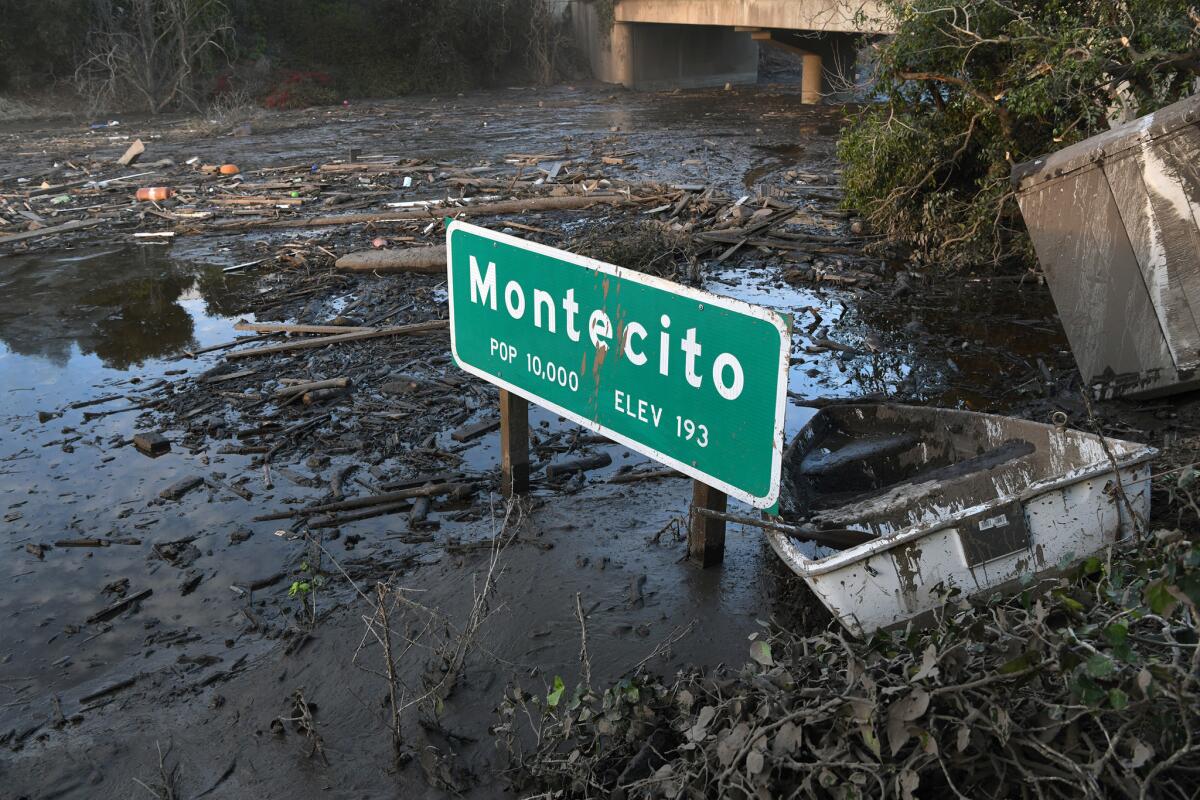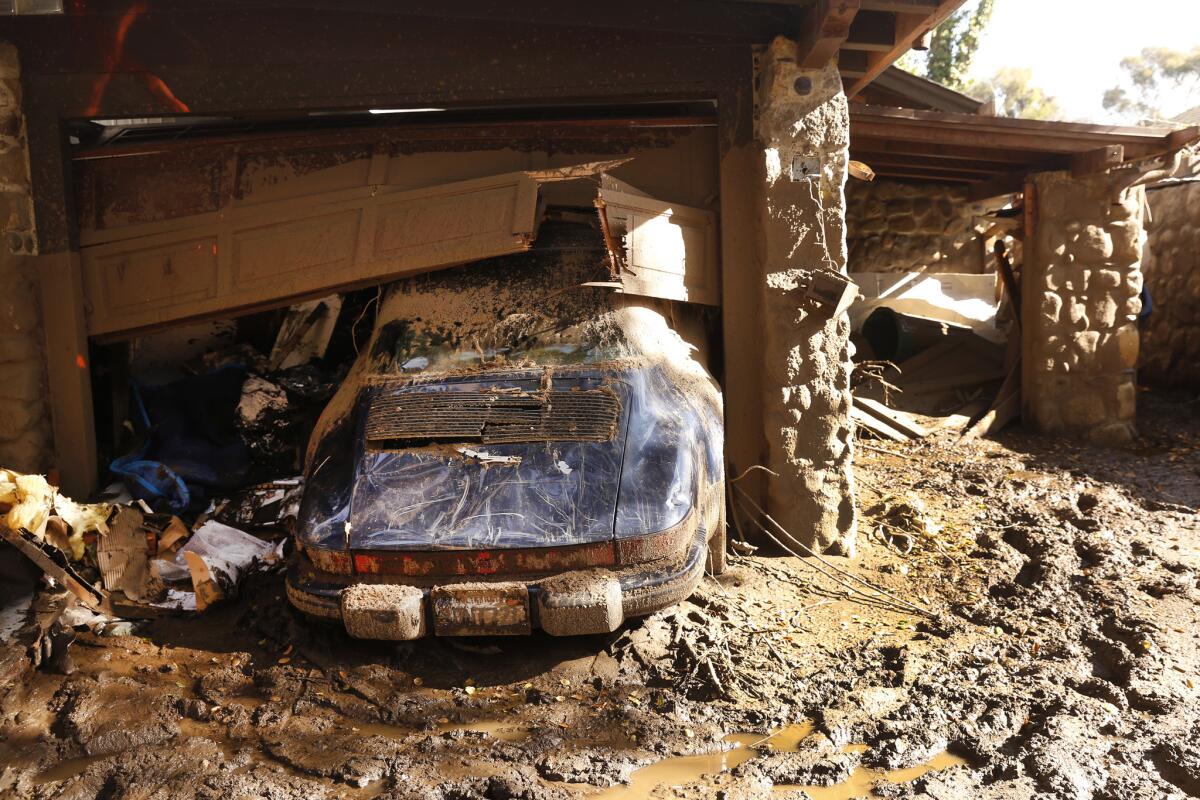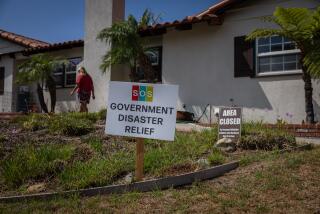Buried in mud, Montecito faces a daunting cleanup with no end in sight

- Share via
Reporting from Montecito — The cobbled parking lots outside boutiques are empty. The Italian trattoria known as Oprah Winfrey’s favorite haunt is shuttered, as is the Four Seasons resort owned by Ty Warner, the Beanie Babies tycoon.
A place famous for coastal affluence and extravagance is now unlivable and grappling with one basic and primitive question: Where to put all the mud?
The picturesque topography that drew the rich and famous here, hills and mountains rising dramatically from Pacific Ocean, fed the destructive mudslides that killed at least 20 people, wiped out 73 homes and damaged hundreds more.
The disaster leaves Montecito with a cleanup that is hard to fathom, and with no timetable for completion. Many streets have limited access because of the mud. Bridges are washed out. Power and gas are shut off for thousands. And when the water does come out of faucets, it’s not drinkable.
For Montecito to recover, it must first move tons and tons of mud.
Who they were: The victims of the Montecito mudslides »

The mud is bad; the dirt is different
Santa Barbara County officials were hauling “lots and lots of dump trucks” to a site in Summerland, where it was dried, sorted and stockpiled. At beaches in Goleta and Carpinteria, dump trucks unloaded tons of mud and sediment onto the sand. Public health officials shut down several beaches along the coast after tests showed abnormally high levels of bacteria.
“The problem over the last three days was the wetness,” said Chris Sneddon, deputy director of Santa Barbara County Public Works. “It was runny, like trying to pick up soup in your hands and put it into a bowl without leaking.”
Now the mud has begun to dry — spackled onto the pavement or pushed to toward the curbs like mounds of fudge topping several feet.
“It’s heavy,” said Ben Chrestenson, whose crew of 40 workers helped clear out the mud-clogged garage at the Montecito Inn and other streets in the shopping district along Coast Village Road. “It has the consistency of concrete.”
He used a broom to sweep dried dirt off the sidewalk as a dozer plowed the CVS parking lot across the street. Cleaning with power washers would have to wait: There was nowhere to drain the water.
“You can’t just rinse it off to your neighbors,” he added. Chrestenson leaned on the broom outside the Honor Bar — a popular nightspot, now closed. He pointed to a mud-caked photo of an infant that was unearthed in the rubble.
“People’s lives just tore through here,” he said. He knew more discoveries would await.

‘This is impacting everything’
Montecito is accustomed to dealing with natural calamity. Brush fires roar through the hills every few years and periodic storms batter the coast. But the mud — piled up with cars, rocks, tree trunks and refrigerators — is a disaster on a different scale.
“In wind storms, the power lines are down. In rain, the sewers may clog,” Sneddon said. “This is impacting everything: gas, power, sewer, communications, and roads. And we have a high level of damage in a concentrated area.”
For the medley of agencies involved, the response is a puzzle that’s always in flux: Search teams can’t use chainsaws or cutters if ruptured gas lines are leaking. Sanitation crews can’t operate pumps without electricity. And no rescuer can reach the wreckage if streets are blocked.
The top priority is to keep the 50 miles of roads and 25 bridges merely passable for firefighters as well as bulldozers, dump trucks and cranes. Open and drivable was the goal.
“We’re not working on getting them beautiful,” Sneddon added.
Crews are also breaking up large rocks, clearing 250 culverts and trying to open up debris basins — tasks that are more urgent as forecasters predict storms later this week.
“There’s already a lot of debris, mud and boulders. When it does rain, it makes it so stuff can move,” Sneddon said. “It’s going to be a constant effort to keep the area clear.”
The 101 Freeway remained closed here after a swampy bayou formed in the highway’s lowest point, right next to the Montecito Inn. Jim Shivers, a Caltrans spokesman, said the freeway was shut down indefinitely as crews labored to pump out water and debris.
The drying mud on the sides of an abandoned black Range Rover offered a yardstick of progress in the freeway. So far, the swamp line had dropped about one foot.
“Highway 101 will reopen. I can guarantee it,” Shivers said. “I just can’t say when.”
The absence of a recovery timeline was the new normal.
“We’re not done assessing,” said David Song, a spokesman for Southern California Edison. About 1,500 customers remained without power, and so far, officials confirmed 62 power lines were toppled.
In the field, 20 crews — each with three to six people — have barely recognized the area. Homes were flattened. Pools were stuffed with sludge. The concrete foundations sometimes peek out, the only indicators of what once was.
“The mudslides created new terrain,” Song said. “We have to completely re-engineer and rebuild infrastructure on new ground.”
Mudflows knocked out six sections of Montecito’s main water line that snakes along the hills above most homes. There, a pipeline once partly aboveground is now sometimes 50 feet in the air after the ravines beneath it washed out. Access is difficult — and some crews have to reach it by foot. Debris flows also knocked out a 100-foot section of the pipeline to Jameson Lake, which accounts for up to 40% of the area’s water supply.
For those who have water, pressure can be low, and they are required to boil it.
“I’m hopeful that very soon we’ll be providing water,” said Nick Turner, general manager of the Montecito Water District. “We’re not days away, but certainly sometime before the next two months.”
Another 3,600 Southern California Gas Co. customers were without service.
Workers were still trying to stop the gas leaks, which sometimes required shutting down whole swaths of the town, said Jimmie Cho, a vice president with the utility.

Residents running low
Those who defied evacuation orders remain cloistered in their homes, with food and water supplies dwindling. California Highway Patrol officers stand at checkpoints across the town of about 10,000, reminding those who left that they cannot return.
Barbara Mathews, a physician who owns a gated eight-acre ranch high in the hills, pressed a CHP officer at one checkpoint to allow her to pass. As he waved in firefighters and gas company crews, the officer refused her entreaties.
“It’s frustrating not to know how my house is and what to do,” said Mathews, who was now living at her late parents’ home in Santa Barbara. “I’m going to pray it’s all right. I’m worried about my barn, stable and little cottage.”
Randy Hill, 59, stayed put through the evacuation, living off a stock of food and 10 gallons of distilled water. But he lost gas service in his townhouse in central Montecito on Saturday as repairs were underway. His propane tank was low.
“We’ve hunkered down but are thinking about leaving,” said Hill. The car was already packed.
Twitter: @MattHjourno
More to Read
Sign up for Essential California
The most important California stories and recommendations in your inbox every morning.
You may occasionally receive promotional content from the Los Angeles Times.














